Abstract
The cerebellum is the great coordinator of muscle action and is important for learning motor tasks. It synchronizes contractions of muscles within and among groups, smoothing out responses by delicately regulating and grading muscle tensions. Thus, it plays an important role in equilibrium and muscle tone. Located in the posterior cranial fossa, beneath the tentorium cerebelli and behind the pons and medulla, the cerebellum processes sensory input related to the ongoing motor activity, all on an unconscious level. It plays no part in conscious perceptions or intelligence, although there is good evidence indicating that it is involved in nonmotor functions.
Access this chapter
Tax calculation will be finalised at checkout
Purchases are for personal use only
Suggested Readings
Altman J, Bayer SA. 1977. Time of origin and distribution of a new cell type in the rat cerebellar cortex. Exp Brain Res. 29:265–274.
Dino MR, Schuerger RJ, Liu Y, Slater NT, Mugnaini E. 2000. Unipolar brush cell: a potential feedforward excitatory interneuron of the cerebellum. Neuroscience. 98:625–636.
Gebhart AL, Petersen SE, Thach WT. 2002. Role of the posterolateral cerebellum in language. Ann NY Acad Sci. 978:318–333.
Gerrits NM, Ruigrok TJH, de Zeeuw CI, eds. 2000. Cerebellar Modules: Molecules, Morphology, and Function. New York: Elsevier.
Glickstein M. 1992. The cerebellum and motor learning. Curr Opin Neurobiol. 2:802–806.
Hua SE, Houk JC. 1997. Cerebellar guidance of premotor network development and sensorimotor learning. Learn Mem. 4:63–76.
Ito M. 1984. The Cerebellum and Neural Control. New York: Raven.
Ito M. 1993. Synaptic Plasticity in the cerebellar cortex and its role in motor learning. Can J Neurol Sci. 20(Suppl. 3):S70–S74.
Kelly RM, Strick PL. 2003. Cerebellar loops with motor cortex and prefrontal cortex of a nonhuman primate. J Neurosci. 23:8432–8444.
Leiner HC, Leiner AL, Dow RS. 1993. Cognitive and language functions of the human cerebellum. Trends Neurosci. 16:444–447.
Llinás RR, Sotelo C, eds. 1992. The Cerebellum Revisited. New York: Springer-Verlag.
Manto M-U, Pandolfo M. 2002. The Cerebellum and its Disorders. Cambridge: Cambridge University Press.
Middleton FA, Strick PL. 2000. Basal ganglia and cerebellar loops: motor and cognitive circuits. Brain Res Brain Res. Rev. 31:236–250.
Miller LE, Holdefer RN, Houk JC. 2002. The role of the cerebellum in modulating voluntary limb movement commands. Arch Ital Biol. 140: 175–183. Mugnaini E, Sekerkova G, Marco M. 2011. The unipolar brush cell: a remarkable neuron finally receiving the deserved attention. Brain Res Rev. 66: 220–245.
Nunzi MG, Birnstiel S, Bhattacharyya BJ, Slater NT, Mugnaini E. 2001. Unipolar brush cells form a glutamatergic projection system within the mouse cerebellar cortex. J Comp Neuro. 434: 329–341.
Prusiner SB. 1998. Prions. Proc Natl Acad Sci USA. 95:13363–13383.
Raymond JL, Lisberger SG, Mauk MD. 1996. The cerebellum: a neuronal learning machine? Science. 272:1126–1131.
Robinson FR. 1995. Role of the cerebellum in movement control and adaptation. Cur. Opin Neurobiol. 5:755–762.
Thach WT. 1998 A role for the cerebellum in learning movement coordination. Neurobiol Learn Mem. 70:177–188.
Thach WT, Bastian AJ. 2004. Role of the cerebellum in the control and adaptation of gait in health and disease. Prog Brain Res. 143:353–366.
Thompson RF, Kim JJ. 1996. Memory systems in the brain and localization of a memory. Proc Natl Acad Sci USA. 93:13438–13444.
Voogd J. 2003. The human cerebellum. J Chem Neuroanat. 26:243–252.
Voogd J, Glickstein M. 1998. The anatomy of the cerebellum. Trends Neurosci. 21:370–375.
Zagon IS, McLaughlin PJ, Smith S. 1977. Neural populations in the human cerebellum: estimations from isolated cell nuclei. Brain Res. 127: 279–282.
Zeeuw Cide, Strata P, Voogd J. 1997. The Cerebellum: From Structure to Control. New York: Elsevier;
Author information
Authors and Affiliations
Rights and permissions
Copyright information
© 2012 Springer Science+Business Media New York
About this chapter
Cite this chapter
Strominger, N.L., Demarest, R.J., Laemle, L.B. (2012). Cerebellum. In: Noback's Human Nervous System, Seventh Edition. Humana Press, Totowa, NJ. https://doi.org/10.1007/978-1-61779-779-8_18
Download citation
DOI: https://doi.org/10.1007/978-1-61779-779-8_18
Published:
Publisher Name: Humana Press, Totowa, NJ
Print ISBN: 978-1-61779-778-1
Online ISBN: 978-1-61779-779-8
eBook Packages: Biomedical and Life SciencesBiomedical and Life Sciences (R0)

